Sean Barnum
February 20, 2014
Version 1.1, Revision 1
Abstract
It is becoming increasingly necessary for organizations to have a cyber threat
intelligence capability and a key component of success for any such capability
is information sharing with partners, peers and others they select to trust.
While cyber threat intelligence and information sharing can help focus and
prioritize the use of the immense volumes of complex cyber security information
organizations face today, they have a foundational need for standardized,
structured representations of this information to make it tractable. The
Structured Threat Information eXpression (STIX™) is a quickly evolving,
collaborative community-driven effort to define and develop a language to
represent structured threat information. The STIX language is meant to convey
the full range of cyber threat information and strives to be fully expressive,
flexible, extensible, automatable, and as human-readable as possible. Though
relatively new and still evolving, it is actively being adopted or considered
for adoption by a wide range of cyber threat-related organizations and
communities around the world. All interested parties are welcome to participate
in evolving STIX as part of its open, collaborative community via the STIX web
site, email discussion lists and other collaborative forums.
STIX, TAXII, CybOX, MAEC, CAPEC, CVE, CWE and CCE are trademarks of The MITRE
Corporation.
This technical data was produced for the U. S. Government under Contract No.
HSHQDC-11-J-00221, and is subject to the Rights in Technical Data-Noncommercial
Items clause at DFARS 252.227-7013 (NOV 1995)
©2014 The MITRE Corporation. All Rights Reserved.
Feedback
Community input is necessary for the success of STIX. Feedback on this or any
of the other STIX work product is welcome and can be sent to stix@mitre.org.
Comments, questions, suggestions, and concerns are all appreciated.
Table of Contents
- Introduction
- Background
- Current Approaches
- History
- What is STIX?
- Use Cases
- Guiding Principles
- Architecture
- STIX Structure
- Implementations
- Usage
- Conclusion and Future Work
- Acknowledgments
- References
Introduction
This document reflects ongoing efforts to create, evolve, and refine the
community-based development of sharing and structuring cyber threat
information. STIX is built upon feedback and active participation from
organizations and experts across a broad spectrum of industry, academia, and
government. This includes consumers and producers of cyber threat information
in security operations centers, CERTs, cyber threat intelligence cells, and
security executives and decision makers, as well as numerous currently active
information sharing groups, with a diverse set of sharing models. HS-SEDI
serves as the moderator of the STIX community on behalf of the Department of
Homeland Security (DHS) and welcomes your participation.
Background
Cyber security is a complex and multifaceted problem domain and continues to
become more so. Our dependence on complex technology continues to grow and, at
the same time, the threat environment continues to grow and evolve in dynamic
and daunting ways. Traditional approaches for cyber security, that focus inward
on understanding and addressing vulnerabilities, weaknesses and configurations
are necessary but insufficient. Effective defense against current and future
threats also requires the addition of a balancing, outward focus, on
understanding the adversary’s behavior, capability, and intent. Only through a
balanced understanding of both the adversary and ourselves can we hope to
understand enough about the true nature of the threats we face to make
intelligent defensive decisions.
Today’s evolving threat environment also brings with it far more complex attack
scenarios. Alongside commoditized threats, more advanced capabilities that were
rare in the past are now commonplace. Adversary behavior is not solely focused
on widespread, disruptive activity, such as the Storm worm outbreak of years
gone by, but rather it often involves more targeted, lower-profile
multi-stage attacks that aim to achieve specific tactical objectives and
establish a persistent foothold into our enterprises.
This newer attack scenario, and how to defend against it, can be effectively
understood from the defensive perspective of a “kill chain”[9]
showing the multiple steps in an attack. As shown below, the adversary’s attack
unfolds in a series of steps, ending with the attacker having an established
foothold in the victim’s network. This is the modus operandi of today’s
sophisticated advanced persistent threat, more commonly known as the APT. APT
actors are typically assumed to be nation states but the same behaviors can
also be exhibited by those engaged in conducting cyber crime, financial
threats, industrial espionage, hacktivism, and terrorism.

The APT’s desire and apparent capability to persist and cause ongoing damage is
motivating the need to move beyond today’s traditional reactive approaches to
cyber security and become more proactive. Responding to incidents after the
exploit has already occurred is very costly, both in the effective impact and
in the level of effort necessary to root out the adversary’s established
foothold. To be proactive, cyber defenders need to fundamentally change the
nature of the game by stopping the adversary’s advance, preferably before the
exploit stage of the attack illustrated in the kill chain (that is, moving left
of the hack). Moving left of the hack requires defenders to evolve from a
defensive strategy based primarily on after-the-fact incident investigation and
response to one driven by cyber threat intelligence.
Just as traditional intelligence ascertains an understanding of adversaries’
capabilities, actions, and intent, the same value carries over to the cyber
domain. Cyber intelligence seeks to understand and characterize things like:
what sort of attack actions have occurred and are likely to occur; how can
these actions be detected and recognized; how can they be mitigated; who are
the relevant threat actors; what are they trying to achieve; what are their
capabilities, in the form of tactics, techniques, and procedures (TTP) they
have leveraged over time and are likely to leverage in the future; what sort of
vulnerabilities, misconfigurations, or weaknesses are they likely to target;
what actions have they taken in the past; etc.
A holistic understanding of the threat posed by the adversary enables more
effective decision support, prioritization of courses of action and a potential
opportunity to fundamentally affect the balance of power between the defender
and the adversary. According to Hutchins, Cloppert, and Amin [9]:
“The effect of intelligence-driven CND [computer network defense] is a more
resilient security posture. APT actors, by their nature, attempt intrusion
after intrusion, adjusting their operations based on the success or failure
of each attempt. In a kill chain model, just one mitigation breaks the
chain and thwarts the adversary, therefore any repetition by the adversary
is a liability that defenders must recognize and leverage.” “Through this
model, defenders can develop resilient mitigations against intruders and
intelligently prioritize investments in new technology or processes.” “If
defenders implement countermeasures faster than adversaries evolve, it
raises the costs an adversary must expend to achieve their objectives. This
model shows, contrary to conventional wisdom, such aggressors have no
inherent advantage over defenders.”
Cyber threat intelligence itself poses a challenge in that no organization in
and of itself has access to an adequate scope of relevant information for
accurate situational awareness of the threat landscape. The way to overcome
this limitation is via sharing of relevant cyber threat information among
trusted partners and communities. Through information sharing, each sharing
partner can potentially achieve a more complete understanding of the threat
landscape not only in the abstract but also at the instantial level of what
specifics they can look for to find the attacker. The threat that organization
A is facing today may very well be one that organization B will face tomorrow.
This is especially true when A and B both fall within the targeting scope of a
given adversary’s campaign. If organization A can share their personal
instantial knowledge of what they learned/saw about a given threat in the form
of a cyber threat indicator[2], organization B may be able to take
advantage of this knowledge to address the threat while it’s attack on them is
still left of the hack (that is, pre-exploit).
Given the evolving complexities of the threat landscape, the speed at which
events occur, and the vast quantities of data involved in cyber threat
intelligence and threat information sharing, establishing automation to aid
human analysis or execute defensive actions at machine-speed is a prerequisite
for any effective approach. Automation will require a feed of quality
information and most defensive capabilities will typically be built not from
homogenous architectures but rather from a diverse set of differing products
and systems. The combination of all of these factors will require standardized,
structured threat information representations so the widest possible community
of information sources can contribute and leverage information without knowing
ahead of time who will be providing what information.
One of the challenges threat-sharing organizations face is the ability to
structure cyber threat information, yet not lose the human judgment and control
involved in sharing. In many cases, organizations have a desire to exchange
information in a way that is both human-readable as well as machine-parsable.
This requirement is largely an artifact of many information sharing programs
where organizations consume not just the data but also assess the data as part
of an intelligence collection process. This intelligence process is largely
driven by human intelligence analysts that are focused on types of analysis
that are either inappropriate for automation or focused on making decisions
that require a human-in-the-loop where the analyst directly benefits from
reading threat information for situational awareness and context. In addition,
because of the wide range in quality of the shared threat information, the
intelligence analyst is often also assessing the fidelity based upon the
sources and methods used to produce the threat information.
Given all of these factors, there exists a need for structured representations
of threat information that are expressive, flexible, extensible, automatable
and readable. This paper outlines a community-driven solution to this problem
known as the Structured Threat Information eXpression, or STIX.
[2] Cyber Threat Indicator: A set of cyber observables
combined with contextual information intended to represent artifacts and/or
behaviors of interest within a cyber security context.
Current Approaches
STIX is relatively new, but the practice of cyber threat information sharing,
particularly indicators, is not. The information being managed and exchanged
today is typically very atomic, inconsistent, and very limited in
sophistication and expressivity. Where standardized structures are used, they
are typically focused on only an individual portion of the overall problem, do
not integrate well with each other, or lack coherent flexibility. Many existing
indicator sharing activities are human-to-human exchanges of unstructured or
semi-structured descriptions of potential indicators, conducted via web-based
portals or encrypted email. A more recent trend is the machine-to-machine
transfer of relatively simple sets of indicator data fitting already well-known
attack models. Efforts fitting this description include the Research and
Education Networking Information Sharing and Analysis Center’s (REN-ISAC)
Security Event System and its Collective Intelligence Framework component, the
state of Washington’s Public Regional Information Security Event Management
(PRISEM), the Department of Energy’s Cyber Federated Model (CFM), and
CERT.FI’s and CERT.EE’s AbuseHelper.
STIX, however, aims to extend indicator sharing to enable the management and
widespread exchange of significantly more expressive sets of indicators as well
as other full-spectrum cyber threat information.
Currently, automated management and exchange of cyber threat information is
typically tied to specific security product lines, service offerings, or
community-specific solutions. STIX will enable the sharing of comprehensive,
rich, “high-fidelity” cyber threat information across organizational,
community, and product/service boundaries.
History
STIX originally evolved out of discussions among the security operations and
cyber threat intelligence experts on the IDXWG email list (established by
members of US-CERT and CERT.org in 2010 to discuss automated data exchange for
cyber incidents) regarding the development of a standardized representation for
cyber threat indicators. Out of these discussions a rough structured threat
information architecture diagram was created. The original purpose of this
architecture diagram was to clearly define the scope of what sorts of
information should be included within a structured cyber threat indicator and
what sorts of information should be defined in other related structures. This
architecture diagram helped to clarify scope such that initial cuts at a
structured representation for cyber threat indicators could be successfully
drafted. As the concept and initial structure for cyber threat indicators
matured, there was increasing interest from numerous parties in fleshing-out
the rest of the structured threat information architecture. An XML Schema
implementation of the full STIX architecture, incorporating the cyber threat
indicator representation among others, is the result of those discussions and
the vehicle for current ongoing development of the STIX language among a broad
and dynamically growing community.
What is STIX?
STIX is a language, being developed in collaboration with any and all
interested parties, for the specification, capture, characterization and
communication of standardized cyber threat information. It does so in a
structured fashion to support more effective cyber threat management processes
and application of automation.
A variety of high-level cyber security use cases rely on such information
including:
- Analyzing cyber threats
- Specifying indicator patterns for cyber threat
- Managing cyber threat response activities
- Sharing cyber threat information
STIX provides a common mechanism for addressing structured cyber threat
information across and among this full range of use cases improving
consistency, efficiency, interoperability, and overall situational awareness.
In addition, STIX provides a unifying architecture tying together a diverse set
of cyber threat information including:
- Cyber Observables
- Indicators
- Incidents
- Adversary Tactics, Techniques, and Procedures (including attack patterns,
malware, exploits, kill chains, tools, infrastructure, victim targeting, etc.)
- Exploit Targets (e.g., vulnerabilities, weaknesses or configurations)
- Courses of Action (e.g., incident response or vulnerability/weakness
remedies or mitigations)
- Cyber Attack Campaigns
- Cyber Threat Actors
To enable such an aggregate solution to be practical for any single use case
STIX is both flexible and extensible. Existing standardized languages may be
leveraged as optional extensions where appropriate and numerous flexibility
mechanisms are designed into the language. In particular, almost everything in
this definitively-structured language is optional such that any single use case
could leverage only the portions of STIX that are relevant for it (from a
single field to the entire language or anything in between) without being
overwhelmed by the rest. Specific subsets of STIX capabilities can be defined;
and agreed to beforehand in the form of profiles for use within sharing
communities, by tools, etc.
Use Cases
STIX is targeted to support a range of core use cases involved in cyber threat
management. Very simple overviews of these use cases are provided below.
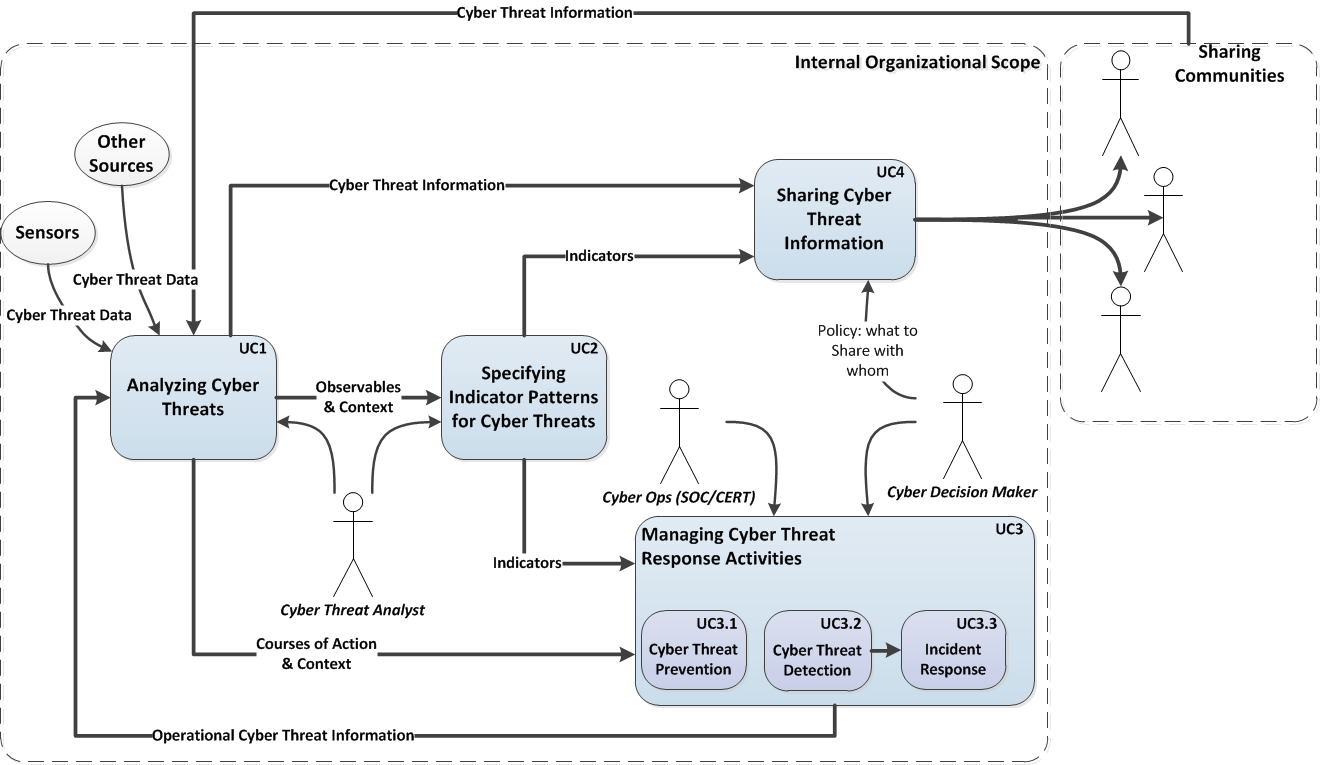
(UC1) Analyzing Cyber Threats
A cyber threat analyst reviews structured and unstructured information
regarding cyber threat activity from a variety of manual or automated input
sources. The analyst seeks to understand the nature of relevant threats,
identify them, and fully characterize them such that all of the relevant
knowledge of the threat can be fully expressed and evolved over time. This
relevant knowledge includes threat-related actions, behaviors, capabilities,
intents, attributed actors, etc. From this understanding and characterization
the analyst may then specify relevant threat indicator patterns, suggest
courses of action for threat response activities, and/or share the information
with other trusted parties. For example, in the case of a potential phishing
attack, a cyber threat analyst may analyze and evaluate a suspected phishing
email, analyze any email attachments and links to determine if they are
malicious, determine if the email was sent to others, assess commonality of
who/what is being targeted in the phishing attack, determine whether malicious
attachments were opened or links followed, and keep a record of all analysis
performed.
(UC2) Specifying Indicator Patterns for Cyber Threats
A cyber threat analyst specifies measurable patterns representing the
observable characteristics of specific cyber threats along with their threat
context and relevant metadata for interpreting, handling, and applying the
pattern and its matching results. This may be done manually or with the
assistance of automated tooling and structured instantial threat information.
For example, in the case of a confirmed phishing attack, a cyber threat analyst
may harvest the relevant set of observables (e.g., to or from addresses, actual
source, subject, embedded URLs, type of attachments, specific attachment, etc.)
from the performed analysis of the phishing email, identify the relevant TTPs
exhibited in the phishing attack, perform kill chain correlation of the attack,
assign appropriate confidence for the indicator, determine appropriate handling
guidance, generate any relevant automated rule patterns for the indicator (e.g.
Snort, YARA, OVAL, etc.), assign any suggested courses of action, and package
it all up as a coherent record for sharing (UC4, below) and future reference.
(UC3) Managing Cyber Threat Response Activities
Cyber decision makers and cyber operations personnel work together to prevent
or detect cyber threat activity and to investigate and respond to any detected
incidences of such activity. Preventative courses of action may be remedial in
nature to mitigate vulnerabilities, weaknesses, or misconfigurations that may
be targets of exploit. After detection and investigation of specific incidents,
reactive courses of action may be pursued. For example, in the case of a
confirmed phishing attack with defined indicators, cyber decision makers and
cyber operations personnel work together to fully understand the effects of the
phishing attack within the environment including malware installed or malware
executed, to assess the cost and efficacy of potential courses of action, and
to implement appropriate preventative or detective courses of action.
(UC3.1) Cyber Threat Prevention
Cyber decision makers evaluate potential preventative courses of action for
identified relevant threats and select appropriate actions for implementation.
Cyber operations personnel implement selected courses of action in order to
prevent the occurrence of specific cyber threats whether through general
prophylactic application of mitigations or through specific targeted
mitigations initiated by predictive interpretation of leading indicators. For
example, in the case of a confirmed phishing attack with defined indicators, a
cyber decision maker may evaluate a suggested preventative course of action
(e.g., implementing a blocking rule at the email gateway) defined within an
indicator for the phishing attack, determine its relevant cost and risk, and
decide whether or not to implement it. If it is decided to implement the
suggested course of action, cyber operations personnel carry out the
implementation.
(UC3.2) Cyber Threat Detection
Cyber operations personnel apply mechanisms (both automated and manual) to
monitor and assess cyber operations in order to detect the occurrence of
specific cyber threats whether in the past through historical evidence,
currently ongoing through dynamic situational awareness, or apriori through
predictive interpretation of leading indicators. This detection is typically
via cyber threat indicator patterns. For example, in the case of a confirmed
phishing attack with defined indicators, cyber operations personnel may harvest
any specified observable patterns from defined indicators of the attack and
apply them appropriately within the operational environment to detect any
evidence of the phishing attack occurring.
(UC3.3) Incident Reponse
Cyber operations personnel respond to detections of potential cyber threats,
investigate what has occurred or is occurring, attempt to identify and
characterize the nature of the actual threat, and potentially carry out
specific mitigating or corrective courses of action. For example, in the case
of a confirmed phishing attack, cyber operations personnel may conduct
investigative activities to determine whether the phishing attack was
successful in carrying out negative effects within the target environment
(e.g., was malware installed or run) and if so, attempt to characterize in
detail those effects (e.g., which systems were affected by malware, what data
was exfiltrated, etc.). Once the effects are understood, cyber operations
personnel would implement appropriate mitigating or corrective courses of
action (e.g. wipe and restore systems, block exfiltration channels, etc.).
Guiding Principles
In its approach to defining a structured representation for cyber threat
information the STIX effort strives to adhere to and implement a core set of
guiding principles that community consensus has deemed necessary. These
principles are as follows:
Expressivity
In order to fully support the diversity of threat-relevant use cases within the
cyber security domain STIX is targeted to provide aggregated expressive
coverage across all of its targeted use cases rather than specifically
targeting one or two. STIX is intended to provide full expressivity for all
relevant information within the cyber threat domain.
Integrate rather than Duplicate
Wherever the scope of STIX encompasses structured information concepts for
which adequate and available consensus standardized representations already
exist, the default approach is to provide appropriate mechanisms to integrate
these representations into the overall STIX architecture rather than attempt to
unnecessarily duplicate them.
STIX directly leverages the following constituent schema:
- Cyber Observable eXpression (CybOX™) [1]
Version 1.1 of STIX provides loose-coupling mechanisms and default
implementations for leveraging the following constituent schemas as
appropriate:
- Common Attack Pattern Enumeration and Classification (CAPEC™) [2]
- Malware Attribute Enumeration and Characterization (MAEC™) [3]
- Common Vulnerability Reporting Framework (CVRF) [8]
- OASIS Customer Information Quality (CIQ) xPRL [18]
Flexibility
In order to support a wide range of use cases and information of varying levels
of fidelity, STIX is intentionally designed to offer as much flexibility as
possible. STIX adheres to a policy of allowing users to employ any portions of
the standardized representation that are relevant for a given context and
avoids mandatory features wherever possible.
Extensibility
In order to support a range of use cases with potentially differing
representation details and to ensure ease of community-driven refinement and
evolution of the language, the STIX design intentionally builds in extension
mechanisms for domain specific use, for localized use, for user-driven
refinement and evolution, and for ease of centralized refinement and evolution.
Automatability
The STIX design approach intentionally seeks to maximize structure and
consistency to support machine-processable automation.
Readability
The STIX design approach intentionally seeks for content structures to not only
be machine-consumable and processable but also to, as much as possible, be
human-readable. This human readability is necessary for clarity and
comprehensibility during the early stages of development and adoption, and for
sustained use in diverse environments going forward.
Architecture
The STIX architecture diagram below identifies the core cyber threat concepts
as independent and reusable constructs and characterizes all of their
interrelationships based on the inherent meaning and content of each.
Connecting arrows between construct icons indicate relationships in the form of
content elements within the construct at the root of the connecting arrow, that
is of the conceptual type of the construct at the head of the connecting arrow
and is suggested but not required to utilize the specific STIX implementation
of that construct. The bracketed asterisk on each of the arrow labels implies
that each relationship may exist zero to many times. The structured content of
each construct is fleshed out in detail within the language implementation
(currently in the form of an XML Schema). The eight core constructs—Observable,
Indicator, Incident, TTP, ExploitTarget, CourseOfAction, Campaign and
ThreatActor— along with a cross-cutting Data Markings construct are briefly
characterized below.
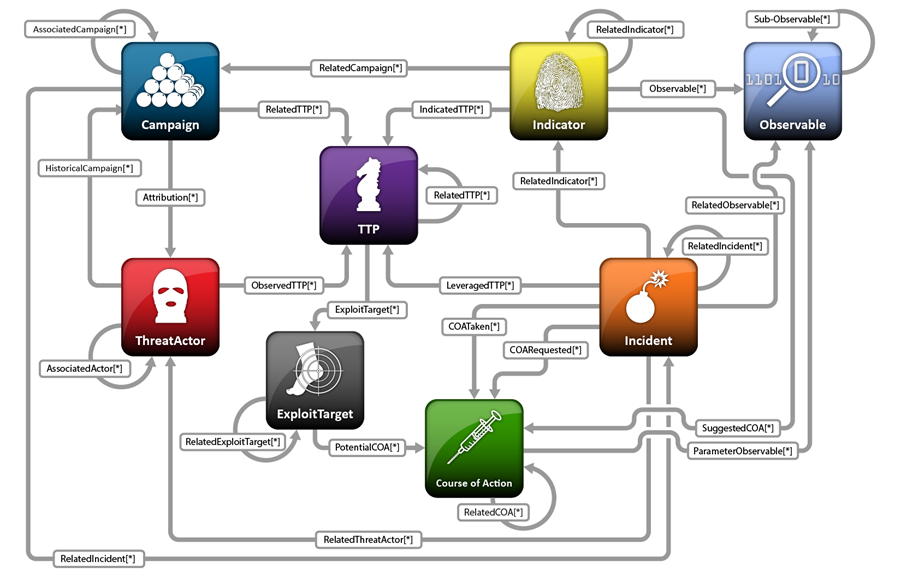
STIX Structure
Observables
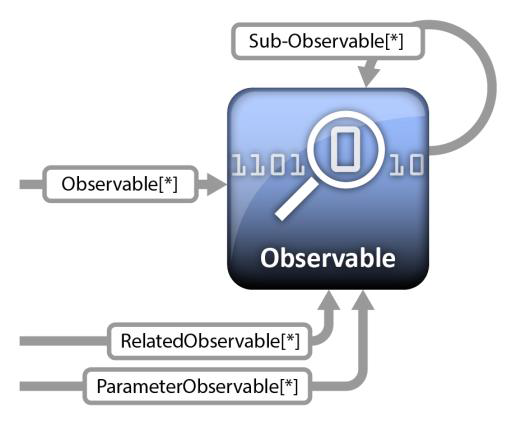
Observables are the “base” construct within the STIX architecture. Observables
are stateful properties or measurable events pertinent to the operation of
computers and networks. Information about a file (name, hash, size, etc.), a
registry key value, a service being started, or an HTTP request being sent are
all simple examples of observables. STIX leverages CybOX for its representation
of Observables.
CybOX is a language for encoding and communicating standardized high-fidelity
information about cyber observables, whether dynamic events or stateful
measures properties that are observable in the operational cyber domain. CybOX,
like STIX, is not targeted at a single cyber security use case but rather is
intended to be flexible enough to offer a common solution for all cyber
security use cases requiring the ability to deal with cyber observables. It is
also intended to be flexible enough to allow both the high-fidelity description
of instances of cyber observables that have been measured in an operational
context as well as more abstract patterns for potential observables that may be
targets for observation and analysis apriori.
Indicators
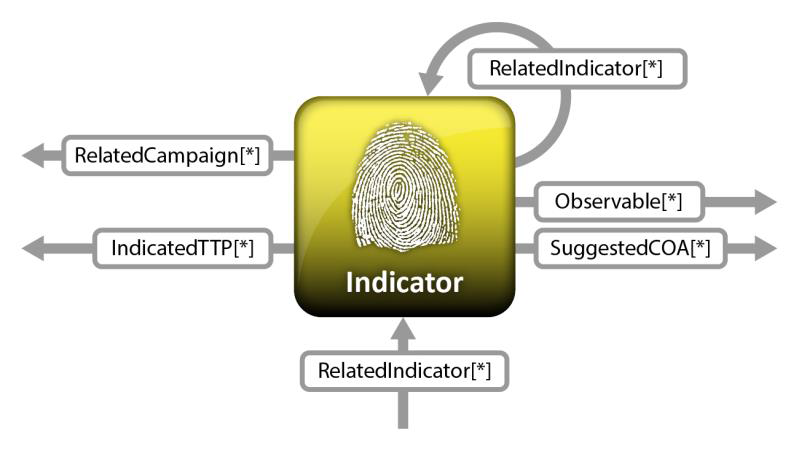
Indicators convey specific Observable patterns combined with contextual
information intended to represent artifacts and/or behaviors of interest within
a cyber security context. They consist of one or more Observable patterns
potentially mapped to a related TTP context and adorned with other relevant
metadata on things like confidence in the indicator’s assertion, handling
restrictions, valid time windows, likely impact, sightings of the indicator,
structured test mechanisms for detection, related campaigns, suggested courses
of action, related indicators, the source of the Indicator, etc.
Recognizing limitations in current standardized approaches of representation,
STIX leverages community knowledge and best practices to define a new Indicator
structure for representing Indicator information.
Incidents
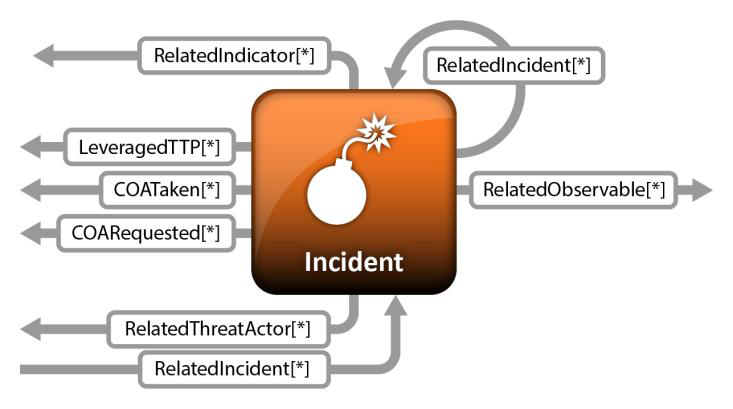
Incidents are discrete instances of Indicators affecting an organization along
with information discovered or decided during an incident response
investigation. They consist of data such as time-related information, parties
involved, assets affected, impact assessment, related Indicators, related
Observables, leveraged TTP, attributed Threat Actors, intended effects, nature
of compromise, response Course of Action requested, response Course of Action
taken, confidence in characterization, handling guidance, source of the
Incident information, log of actions taken, etc.
Recognizing limitations in current standardized approaches of representation,
STIX leverages community knowledge and best practices to define a new Incident
structure for representing Incident information.
Tactics, Techniques, and Procedures (TTP)
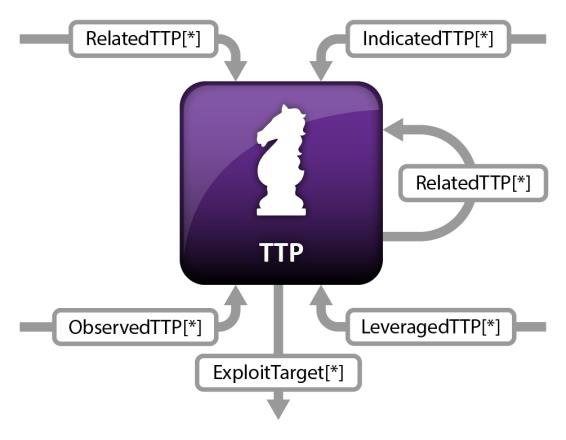
TTPs are representations of the behavior or modus operandi of cyber
adversaries. It is a term taken from the traditional military sphere and is
used to characterize what an adversary does and how they do it in increasing
levels of detail. For instance, to give a simple example, a tactic may be to
use malware to steal credit card credentials. A related technique (at a lower
level of detail) may be to send targeted emails to potential victims, which
have documents attached containing malicious code which executes upon opening,
captures credit card information from keystrokes, and uses http to communicate
with a command and control server to transfer information. A related procedure
(at a lower level of detail) may be to perform open source research to identify
potentially gullible individuals, craft a convincing socially engineered email
and document, create malware/exploit that will bypass current antivirus
detection, establish a command and control server by registering a domain
called mychasebank.org, and send mail to victims from a Gmail account called
accounts-mychasebank@gmail.com.
TTPs consist of the specific adversary behavior (attack patterns, malware,
exploits) exhibited, resources leveraged (tools, infrastructure, personas),
information on the victims targeted (who, what or where), relevant
ExploitTargets being targeted, intended effects, relevant kill chain phases,
handling guidance, source of the TTP information, etc.
TTPs play a central role in cyber threat information and cyber threat
intelligence. They are relevant for Indicators, Incidents, Campaigns, and
ThreatActors. In addition, they hold a close relationship with ExploitTargets
that characterize the specific targets that the TTPs seek to exploit.
Recognizing a lack of current standardized approaches, STIX leverages community
knowledge and best practices to define a new TTP structure for representing TTP
information. However, portions of the TTP construct utilize defined extension
points to enable leveraging of other existing standardized approaches for
detailed characterization of things like behaviors in the form of attack
patterns and malware and resources in the form of tools and infrastructure.
CAPEC may be utilized for structured characterization of TTP attack patterns.
MAEC may be utilized for structured characterization of TTP malware. CybOX is
utilized for characterization of tools and infrastructure.
Campaigns
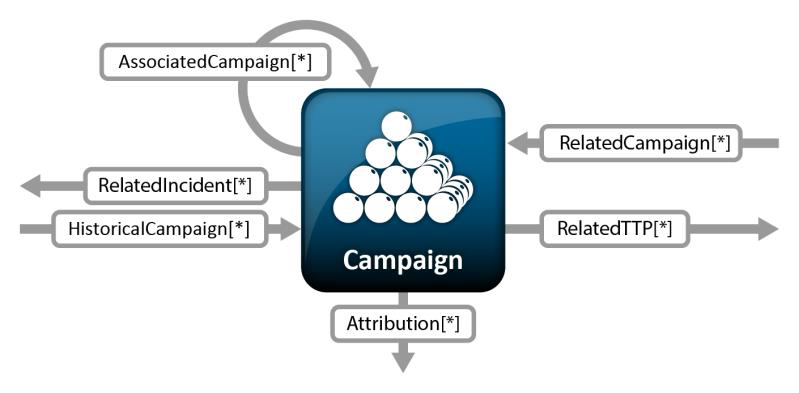
Campaigns are instances of ThreatActors pursuing an intent, as observed through
sets of Incidents and/or TTP, potentially across organizations. In a structured
sense, Campaigns may consist of the suspected intended effect of the adversary,
the related TTP leveraged within the Campaign, the related Incidents believed
to be part of the Campaign, attribution to the ThreatActors believed
responsible for the Campaign, other Campaigns believed related to the Campaign,
confidence in the assertion of aggregated intent and characterization of the
Campaign, activity taken in response to the Campaign, source of the Campaign
information, handling guidance, etc.
Recognizing a lack of current standardized approaches, STIX leverages community
knowledge and best practices to define a new Campaign structure for
representing Campaign information.
Threat Actors
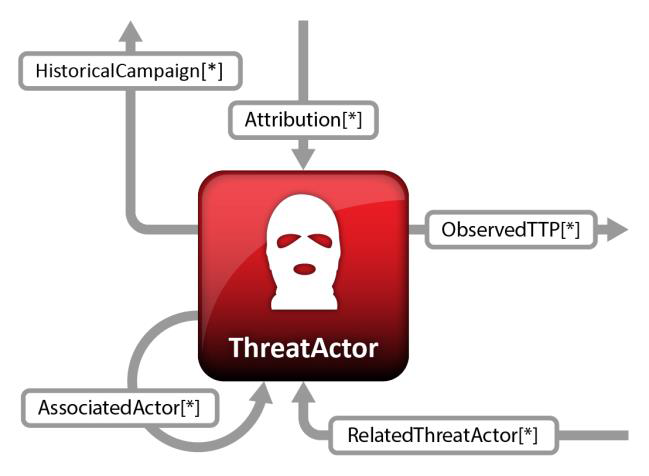
ThreatActors are characterizations of malicious actors (or adversaries)
representing a cyber attack threat including presumed intent and historically
observed behavior. In a structured sense, ThreatActors consist of a
characterization of identity, suspected motivation, suspected intended effect,
historically observed TTP used by the ThreatActor, historical Campaigns
believed associated with the ThreatActor, other ThreatActors believed
associated with the ThreatActor, handling guidance, confidence in the asserted
characterization of the ThreatActor, source of the ThreatActor information,
etc.
Recognizing a lack of current standardized approaches, STIX leverages community
knowledge and best practices to define a new ThreatActor structure for
representing ThreatActor information.
Exploit Targets
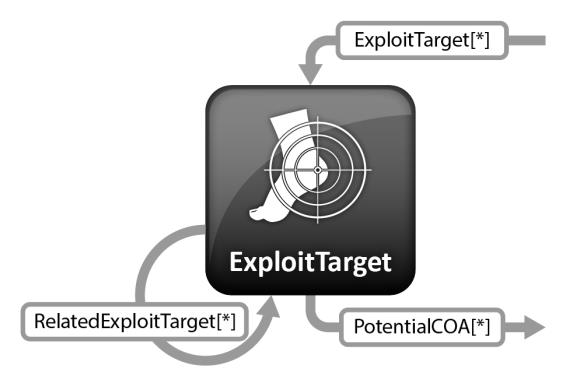
ExploitTargets are vulnerabilities or weaknesses in software, systems, networks
or configurations that are targeted for exploitation by the TTP of a
ThreatActor. In a structured sense, ExploitTargets consist of vulnerability
identifications or characterizations, weakness identifications or
characterizations, configuration identifications or characterizations,
potential Courses of Action, source of the ExploitTarget information, handling
guidance, etc.
Recognizing a lack of current standardized approaches for generalized
characterizations, STIX leverages community knowledge and best practices to
define a new ExploitTarget structure for representing ExploitTarget
information. However, portions of the ExploitTarget structure utilize defined
extension points to enable leveraging of other existing standardized approaches
for characterizing things like vulnerabilities, weaknesses, and configurations.
The identifier constructs from the Common Vulnerabilities and Exposures (CVE®)
and the Open Source Vulnerability Database (OSVDB) are utilized for
identification of publicly disclosed vulnerabilities. The Common Vulnerability
Reporting Framework (CVRF) format may be utilized for detailed structured
characterization of vulnerabilities not identified in CVE or OSVDB including
the potential for characterizing 0-day vulnerabilities. The identifier
construct from the Common Weakness Enumeration (CWE™) is utilized for
identification of weaknesses. The identifier construct from the Common
Configuration Enumeration (CCE™) is utilized for identification of
configuration issues.
Courses of Action (COA)
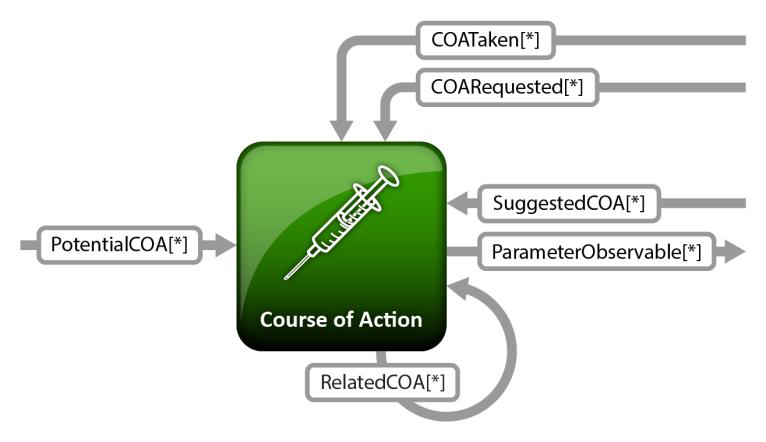
CoursesOfAction are specific measures to be taken to address threat whether
they are corrective or preventative to address ExploitTargets, or responsive to
counter or mitigate the potential impacts of Incidents. In a structured sense,
COA consist of their relevant stage in cyber threat management (e.g., remedy of
an ExploitTarget or response to an Incident), type of COA, description of COA,
objective of the COA, structured representation of the COA (e.g., IPS rule or
automated patch/remediation), the likely impact of the COA, the likely cost of
the COA, the estimated efficacy of the COA, observable parameters for the COA,
handling guidance, etc.
Recognizing a lack of current standardized approaches for generalized
characterizations, STIX leverages community knowledge and best practices to
define a new COA structure for representing Courses of Action information.
Data Markings

A consistent requirement across many of the core STIX constructs is the ability
to represent markings of the data to specify things like handling restrictions
given the potentially sensitive nature of many forms of cyber threat
information. This construct is not conveyed as a separate entity in the STIX
architecture diagram but exists as a cross-cutting structure within all of the
top-level constructs described above. There currently exists no broad consensus
standardized approach for such markings but rather various approaches within
differing communities and driven by different motivations and usage contexts.
Rather than adopting a single marking approach (e.g., Traffic Light Protocol
(TLP)[3]) and attempting to force everyone else to accept it, STIX has taken a
flexible and generic approach.
The Data Markings structure defined for STIX is flexible in two ways. First,
instances are specified independent of the structures being tagged (pointing to
their locations) rather than embedded everywhere which is typically less
efficient and more difficult to update and refine. Second, it allows the
definition and use of any data marking structure simply as an abstraction from
a base type structure. This allows varying marking schemes to be leveraged and
when combined with the independent specification described above it can also
easily enable marking any given data structure with multiple different marking
schemes for leveraging within different use cases or by different communities.
The initial implementation of this Data Marking structure has been created
utilizing XML Schema (XSD) and has the potential to be leveraged not only
throughout an XML implementation of STIX but also for any other XML-based
structured representation.
[3] http://www.us-cert.gov/tlp/
Implementations
The initial implementation for STIX is utilizing XML Schema as a ubiquitous,
portable and structured mechanism for detailed discussion, collaboration and
refinement among the communities involved. It also provides a practical
structure for real-world prototyping and proof-of-concept implementations in
structured threat information management and sharing. This sort of real-world
usage of the language will be encouraged and supported through the development
of various supporting utilities such as programmatic language bindings,
representation translation transforms, APIs, etc. Only through appropriate
levels of collaborative iteration among a relevant community of experts and
vetted through real-world data and use cases can a practical and effective
solution evolve.
The structure for the language is also planned to be abstracted into an
implementation-independent specification. This will then enable other potential
implementations to be derived including possibilities such as semantic web
(RDF/OWL), JSON-centric, ProtocolBuffers, etc.
Usage
STIX has garnered significant interest from a broad range of organizations and
communities facing the challenges of undertaking or supporting cyber threat
intelligence and information sharing. Examples of organizations that have
already chosen to begin leveraging STIX (or its constituent components) to
convey cyber threat information include:
- The U.S. Department of Homeland Security (DHS) is leveraging STIX in a
number of critical areas including the Trusted Automated eXchange of Indicator
Information (TAXII)[4] effort which allows the Office of
Cybersecurity and Communications (CS&C) and its partners in both government and
the private sector to exchange data elements and relationships defined by STIX
using secure automated mechanisms. Through the use of STIX, they seek to enable
the rapid detection, prevention and mitigation of cyber threats and where
possible, automate key elements of this process. Initial proof-of-concept
efforts for TAXII are currently underway.
- The DHS Cyber Information Sharing and Collaboration Program (CISCP) is
currently utilizing STIX for publication of all of its operational threat
information to program partners.
- The DHS National Cybersecurity and Communications Integration Center
(NCCIC) is phasing in STIX-based production of all of its cyber threat-related
operational products.
- In Q2 2012, the Financial Services Information Sharing and Analysis Center
(FS-ISAC) agreed to implement the STIX architecture (including CybOX) for cyber
threat information sharing amongst its constituent members in the financial
services arena. As of May 2013, FS-ISAC stood up an operational threat
information repository utilizing STIX and available to all of its ~4200 member
organizations.
- In July 2013, Microsoft announced that they will be leveraging STIX for
sharing threat information via their new MAPP for Responders program.
- In September 2013, HP announced its new Threat Central threat intelligence
sharing environment based on STIX.
- The Japanese IPA (Information-technology Promotion Agency, Japan) is
currently undertaking an active feasibility study of applying elements of the
STIX architecture (CybOX, MAEC, etc.) as an international exchange format for
cyber observables and threat information.
In addition, STIX (and its constituent components) is under active
consideration for use and initial prototyping among a large variety of
different U.S. and international public-public, public-private and
private-private cyber threat information sharing communities and by several
vendors supporting the domain.
[4] http://taxii.mitre.org
Conclusion and Future Work
There is an urgent need for new and more outward-looking collaborative
approaches to cyber security defense. Cyber threat intelligence and cyber
threat information sharing are on the leading edge of novel approaches with a
high potential for shifting the balance of power between the attacker and the
defender. A core requirement for maturing effective cyber threat intelligence
and cyber threat information sharing is the availability of an
open-standardized structured representation for cyber threat information. STIX
is a community-driven effort to provide such a representation adhering to
guiding principles to maximize expressivity, flexibility, extensibility,
automatability, and readability. STIX provides expressive coverage of the
full-spectrum of cyber threat information—observables, indicators, incidents,
TTP, exploit targets, courses of action, threat actors and campaigns—to provide
support for a broad set of cyber security defense use cases. Though relatively
new and still evolving, STIX has already generated a great deal of interest
from a wide range of stakeholders and communities, both public and private.
Evidence so far indicates that STIX has a high potential to be a solution to
the cyber threat information problem that is effective, practical, and
acceptable to the community of practitioners and supporting entities.
The STIX effort foresees increasing levels of community involvement as it
continues to gain awareness and initial real-world use. Community effort will
be focused on evaluation and refinement of the schematic implementation of the
language (eventually leading to the abstraction to an
implementation-independent language specification), on continued prototyping
and use, and on development of supporting utilities. In addition, effort will
be applied to the establishment of a branding and adoption program to
facilitate and support the emerging ecosystem of products, services, and
information sources that can be leveraged together to address cyber threat
information sharing.
All parties interested in becoming part of the collaborative community
discussing, developing, refining, using and supporting STIX are welcome and
invited to join the effort. More information is available on the STIX website. Questions or comments may be sent to the STIX team at
stix@mitre.org or to the STIX community on the STIX discussion list. Access to full schema
implementations, utilities and issue trackers is available from the STIX Project GitHub site.
Acknowledgments
HS SEDI’s services as community coordinator of the STIX effort and editor of
this paper are provided under the sponsorship of the U.S. Department of
Homeland Security. While the summary work contained in this paper is based on
the efforts, comments, and conversations on these topics by a large number of
individuals from many organizations, special thanks is made for those
individuals that took time to review and comment on the specific text in this
document.
A sampling of some of the organizations contributing to the STIX discussion
includes:
- MITRE Corporation
- United States Computer Emergency Readiness Team (US-CERT)
- DHS Cyber Information Sharing and Collaboration Program (CISCP)
- DHS National Cybersecurity and Communications Integration Center (NCCIC)
- Enhanced Shared Situational Awareness (ESSA)
- National Institute of Standards and Technology (NIST)
- Financial Services Information Sharing and Analysis Center (FS-ISAC)
- CERT Coordination Center (CERT/CC)
- Research and Engineering Networking Information Sharing and Analysis Center
(REN-ISAC)
- Industrial Control System Information Sharing and Analysis Center
(ICS-ISAC)
- Electricity Sector Information Sharing and Analysis Center (ES-ISAC)
- National Health Information Sharing and Analysis Center (NH-ISAC)
- Department of Defense Cyber Crime Center (DC3)
- National Cyber Investigative Joint Task Force Analytical Group (NCIJTF-AG)
- Depository Trust & Clearing Corporation (DTCC)
- Goldman Sachs
- American Express
- USAA
- GE
- Siemens
- Visa
- Microsoft
- HP
- Check Point
- CrowdStrike, Inc.
- FireEye/Mandiant
- CyberIQ
- LookingGlass
- iSIGHT Partners
- Red Sky Alliance
- Damballa
- esentire
- Tripwire
- Verisign
- Verizon
- Lockheed Martin
- General Dynamics
- Northrop Grumman
- Booz Allen Hamilton
- Threat Stream
- ThreatGRID
- Bromium
- Reversing Labs
- Cyber2/ThreatConnect
- Internet Identity
- Fortinet
- Fishnet Security
- StegoSystems
- G2, Inc.
- Cyveillance
- Critical Intelligence
- Incident Logic
- Punch Cyber Analytics Group
- NCI Security LLC
- Foreground Security
- SHARKSEER Program
- Public Regional Information Security Event Management (PRISEM)
- NATO
- World Bank
- CERT-EU
- Gendarmerie Nationale (France)
- Trustworthy Software Initiative (TSI) (UK Software Security)
References
[1] Cyber Observable eXpression (CybOX). URL
https://cybox.mitre.org
[2] Common Attack Pattern Enumeration and Classification
(CAPEC). URL https://capec.mitre.org
[3] Malware Attribute Enumeration and Characterization
(MAEC). URL https://maec.mitre.org
[4] Common Vulnerabilities and Exposures (CVE). URL https://cve.mitre.org
[5] Common Weakness Enumeration (CWE). URL https://cwe.mitre.org
[6] Common Configuration Enumeration (CCE). URL https://cce.mitre.org
[7] Open Source Vulnerability Database (OSVDB). URL http://www.osvdb.org
[8] Common Vulnerability Reporting Framework (CVRF). URL
http://www.icasi.org/cvrf/
[9] E.M. Hutchins, M.J. Cloppert and R.M Amin PH.D.,
“Intelligence-Driven Computer Network Defense Informed by Analysis of Adversary
Campaigns and Intrusion Kill Chains,” Proc. 6th Int’l Conf. Information Warfare
and Security (ICIW 11), Academic Conferences Ltd., 2010, pp. 113–125; URL
http://www.lockheedmartin.com/content/dam/lockheed/data/corporate/documents/LM-White-Paper-Intel-Driven-Defense.pdf
[10] Luc Dandurand, Emmanuel Bouillon and Philippe Lagadec, “High-level
Requirements for a Cyber Defence Data Collaboration and Exchange
Infrastructure,” Reference Document 3175, NATO Consultation, Command and
Control Agency, April 2011.
[11] “TAXII: The Trusted Automated eXchange of Indicator Information,” U.S.
Department of Homeland Security
[12] ”Cyber Information-Sharing Models: An Overview,” MITRE Corporation, May
2012.
[13] ”Active Defense Strategy for Cyber,” MITRE Corporation, July 2012.
[14] ”A New Cyber Defense Playbook,” MITRE Corporation, July 2012.
[15] IDXWG@NICWG.ORG, Oct 2011 - May 2013
[16] Traffic Light Protocol (TLP). URL http://www.us-cert.gov/tlp/
[17] Julie Connolly, Mark Davidson, Matt Richard, Clem Skorupka, “The Trusted
Automated eXchange of Indicator Information (TAXIITM),” November 2012.
http://taxii.mitre.org/about/documents/Introduction_to_TAXII_White_Paper_November_2012.pdf
[18] OASIS Customer Information Quality (CIQ) xPRL. URL
https://www.oasis-open.org/committees/ciq/












